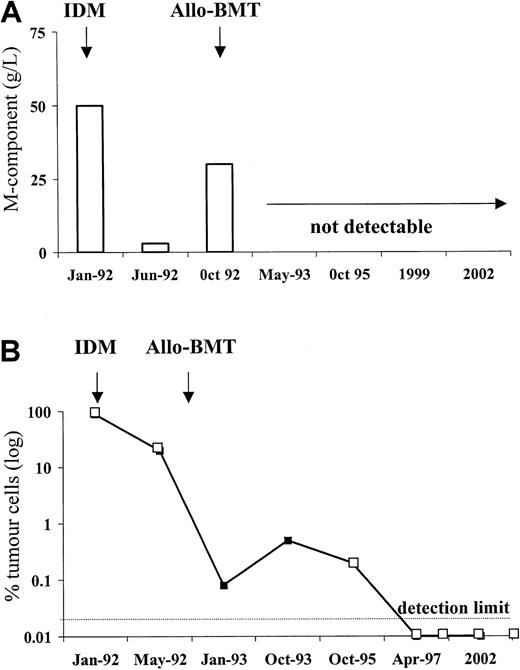Partial or complete deletion of chromosome 13 (del13) is considered one of the most important prognostic factors for multiple myeloma (MM).1-4 The impact of del13 on the outcome of allogeneic stem cell transplantation is unknown. We describe 2 patients with unfavorable MM who benefited from a graft-versus-myeloma effect, resulting in sustained molecular remissions.5Retrospectively a del13 was found in the diagnostic bone marrow (BM) aspirates of both patients.
The first patient progressed from monoclonal gammopathy of undetermined significance (MGUS; diagnosed in 1982) to MM (1991, IgA λ, stage IIIA). She was refractory to melphalan+prednisone, and in March 1992 at age 48 she received a partial T-cell–depleted (1 × 105 T cells/kg) BM transplant from her HLA-identical sister after conditioning with cyclophosphamide (120 mg/kg) and total body irradiation (12 Gy). This was complicated by transient acute graft-versus-host disease (GVHD), grade I. At the time of transplantation, her BM contained 55% myeloma cells. After achieving a partial remission (PR; disappearance of M protein, 8% residual BM cells), she relapsed 8 months after transplantation: reappearance of M protein, increasing 10 months later to 20g/L, 30% BM infiltration. She then received donor lymphocyte infusions (DLIs), 3.3 × 108 T cells/kg. DLIs were complicated by severe extensive chronic GVHD of skin and joints. Since May 1994 she is in complete clinical and molecular remission as demonstrated by absence of M protein, normalization of BM, and quantitative allele-specific oligonucleotide (ASO)–PCR6 (sensitivity to detect 1 tumor of 1 × 105 normal cells). Molecular remission was demonstrated in 8 subsequent BM aspirates.
The second patient (stage IIIA, IgG κ) presented with bone pain and diplopia. His BM showed a 99% infiltration, labeling index 3%, and β2-microglobulin level of 5 mg/mL. The liquor was infiltrated with plasmablastic cells. He achieved a PR after induction with intermediate-dose melphalan7 but relapsed just before allogeneic (allo)–BMT. In the liquor a persistent M protein of 1 g/L was found after treatment with methotrexate and cytarabine intrathecally. Evaluation 6 months after transplantation showed a complete clinical remission. Residual myeloma cells however could be detected by quantitative ASO-PCR until 36 months after transplantation (Figure1). Double-color FISH was performed on thawed cytocentrifuged BM cells, which had been prepared from diagnostic samples and had been stored at −20°C. A del13 was found in 99 of 100 myeloma cells of patient 1 and in 35 of 100 myeloma cells of patient 2.
Longitudinal measurement of disease activity in a MM patient with del13.
The patient presented with a combination a unfavorable prognostic features including del13. After allogeneic bone marrow transplantation performed during relapse, he went into sustained clinical (A) and molecular (B) remission. Remarkable residual MM cells were detected by quantitative PCR more than 3 years after disappearance of myeloma proteins (B).
Longitudinal measurement of disease activity in a MM patient with del13.
The patient presented with a combination a unfavorable prognostic features including del13. After allogeneic bone marrow transplantation performed during relapse, he went into sustained clinical (A) and molecular (B) remission. Remarkable residual MM cells were detected by quantitative PCR more than 3 years after disappearance of myeloma proteins (B).
The 2 patient histories demonstrate that alloreactivity may overcome the prognostic unfavorable impact of del13 in myeloma. The first patient is in molecular remission more than 10 years after allo-BMT and 8 years after DLIs. The second patient presented with a combination of adverse prognostic factors including a high β2-microglobulin level, high labeling index, and meningeal infiltration. He received a transplant in relapse after a very short period of remission. Remarkable, quantitative PCR became negative not until 3 years after transplantation.
Our results suggest that in patients with del13 a search for an HLA-identical family or unrelated donor is justified. The promising results of nonmyeloablative allo-SCT in MM8 9 justify inclusion of patients in such protocols as soon as unfavorable factors are identified after diagnosis.


This feature is available to Subscribers Only
Sign In or Create an Account Close Modal